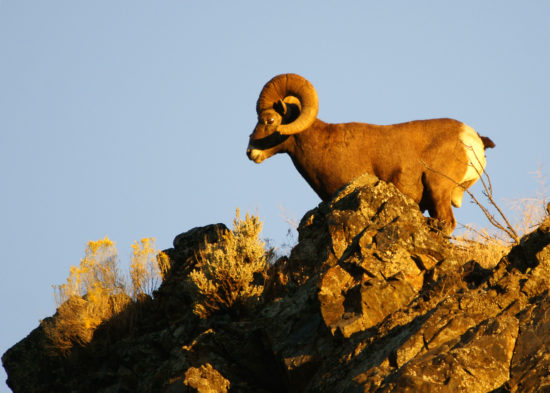Sheep Pneumonia Kills 11 Okanogan Bighorns; Monitoring Continues
A pneumonia outbreak may have run its course in a herd of Okanogan County bighorn sheep after killing nearly a dozen this past winter, but wildlife managers will keep monitoring the animals.

“Today the herd looks healthy, the lambs are healthy and fun to watch,” said WDFW wildlife biologist Jeff Heinlen, who was observing the Mt. Hull sheep this morning. “Boy, they’re active, up on the rocks, jumping around.”
It’s been a month and a half since the last new mortality and Heinlen counted 44 sheep, including 10 two-week-old-or-so lambs, along with 15 rams amongst the herd that roams across the mountain just southeast of Oroville.
In mid-March, WDFW reported one ram had been confirmed to have died from Mycoplasma ovipneumoniae — M. ovi for short — and afterwards asked the public to keep an eye out for any others displaying symptoms of the highly contagious bacteria.
Typically it starts with infected animals licking their lips, then coughing before eventually foaming at the mouth right before they die.
The agency’s early April bimonthly Wildlife Program report states that all totaled nine rams, one ewe and one of last year’s lambs are known to have succumbed, but that no new cases have been seen since March 30.
Heinlen says that six carcasses were sent to a Washington State University lab which confirmed they had all died from sheep pneumonia. Typically it is picked up from domestic herds.
It wasn’t clear why mortality was so concentrated among rams, but possibly because a bachelor group came into contact with someone’s sheep.
Both WDFW and the Colville Tribes, which comanage the herd, withdrew the two ram and four ewe permits that were otherwise going to be available for this fall’s seasons due to the outbreak.
“There are still some pretty nice rams,” noted Heinlen.
While his latest count of 44 sheep is well below the 71 he saw in February and 80 to 82 tallied by the tribes during a January aerial survey, the animals have been using more forested terrain that makes it harder to get a headcount.
Heinlen said it’s easier to spot dead rams on the landscape due to their body size and large horns, but also said he wasn’t seeing eagles or magpies, which would suggest more carcasses on the ground.
This is the first time that M. ovi has been found in the Mt. Hull herd, he reported. It has struck others in Washington, including Yakima River Canyon, Tieton River and Snake-Grande Ronde populations.
“Bottom line, we’re not seeing the catastrophic die-off of other herds. We don’t know if it’s run its course, but we will continue to monitor the herd,” Heinlen said.
They’ll be watching those playful newborn lambs closely in hopes none come down with symptoms.
